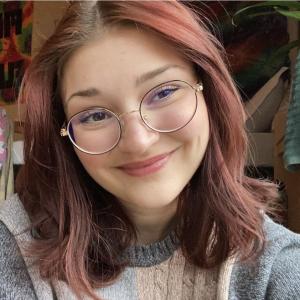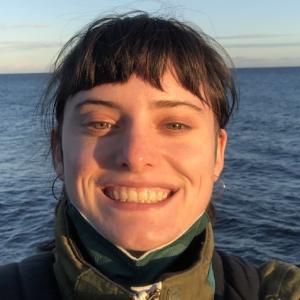Oberlin Blogs
A Final I Liked Writing and an Introduction to Research at Oberlin
June 1, 2022
Biba Duffy-Boscagli ’23
Last semester I wrote a final that I really enjoyed researching. In the chaos of finals week I may not have felt the same way or used the same words to describe the paper writing experience, but with time to reflect on the research I conducted and the writing I did, I can wholeheartedly say I enjoyed the final. The fifteen-page paper was a cumulative project from Professor Cheng’s art history seminar on the topic of Cultural Heritage, Ownership and Property.
Research has been a large part of my college experience, not only as an art history major but as an Oberlin student. I find that the small class sizes and the direct academic discussions that often occur between students and their professors make major research projects less of a daunting task that must be completed by a deadline and more of an academic process supported by the texts read through the semester and the topics discussed in class. Professor Cheng not only made time at the end of the semester to discuss my interests in the syllabus and past research but also met with every student to hear about their final project proposals and offer support. The curator of East Asian Studies at the Allen Memorial Art Museum was also invited to our class to introduce a series of objects in the Allen’s permanent collection that required further research based on what we had been studying in class. Final proposal presentations were organized by Professor Cheng to ensure that peer editing was a resource that was available to us throughout the final research and writing process. While writing my final, I cited a few of the texts from the course syllabus and found others online, at the library, through the Allen Memorial Art Museum, or by Professor Cheng’s recommendation. I can’t speak for all departments but as an art history student, where research could potentially be integral to a future career in the arts, I feel that the research I conduct is directly supported by my professors, peers and advisors. I write this blog both as a small insight into the process and product of research at Oberlin and as an introduction to a research project and paper that I enjoyed writing recently.
Professor Cheng’s seminar primarily focused on East Asian artifacts with an emphasis on Buddhist objects. Not only did the course include art historical analysis of ancient artifacts and objects, Professor Cheng included art historian reviews, art criticism, the artifacts' role in a museum space, art dealership analysis, and the legal implications of cultural property and ownership. Though I came into the class with a small knowledge of the subject, I had a much stronger understanding of how cultural property is perceived and approached in the context of East Asian artifacts by the end of the semester.
The idea for my final paper came from my interest in the legal obligations of a museum as they acquire ancient artifacts and the Longmen Caves in China. The Allen Memorial Art Museum offers a myriad of resources to Oberlin students in terms of research and professional opportunities. While delving into the background of the Sixth-Century Seated Bodhisattva, an object that is part of the Allen Memorial Art Museum’s permanent collection, I was able to read the object’s file and conduct further research based on the museum’s archive of letters, notes and newspaper clippings attached to the object.
Though difficult to comprehensively explain a large body of research, my paper both describes and questions the provenance of the Sixth-Century Bodhisattva. Provenance refers to the background of the object including where it came from, whose hands it passed through before arriving at the museum and the conditions of the object in relation to where it has traveled from. In 1948, the museum bought Sixth-Century Seated Bodhisattva from C.T. Loo, a famous and controversial art dealer of Chinese artifacts. The work was carved out of and taken from the Longmen Grottoes near Luoyang, China, where over 2,354 caves boast Buddhist reliefs.
The sole provenance upon purchase of Seated Bodhisattva was a letter from Loo claiming the object came from the Ping-Yang Tung Cave. Though I do not have the resources to make a definitive claim regarding the Bodhisattva’s origins, I argue that the artifact comes instead from the Guyang Cave. By forming a body of evidence as credible as Loo’s meager letter, I am able to discredit Loo’s claim. I first unravel Loo’s role in Chinese artifact sales in international art markets to offer a potential motive for false provenance. Then, a formal comparison between the Allen’s Seated Bodhisattva and a similar Reicherter Museum Bodhisattva, as well as historical comparisons between the Ping-Yang and Guyang Caves, builds a body of evidence that convincingly contradicts Loo’s claim. The combination of artistic, historical and spatial comparisons ultimately ignites a larger conversation on the crucial nature of provenance, the relationships between museums and art dealers, and the ethics of museum display of Seated Bodhisattva.
My research on the provenance of the Seated Bodhsittva and C.T. Loo was originally conducted as a contribution to the upcoming Allen Memorial Art Museum exhibition that will cover the topics debated in our seminar and cultural heritage in the context of ancient artifacts. Though my research was conducted with the ultimate purpose of museum curation, when I submitted an abstract to the Johns Hopkins Macksey Symposium for undergraduate research in the humanities, my research also became an avenue through which I could gain feedback on my research and learn more about how the Allen’s Sixth-Century Seated Bodhisattva can be considered in an interdisciplinary way by other undergraduate students also conducting research.
I presented my paper over Zoom in March of this semester, and was placed in a cohort of other students who had researched 6th-century China from a historical perspective, or other ancient artworks as they pertain to property and ownership. Not only did I have the chance to revisit my own research months after completing my paper, but the discussion that followed our presentation offered a new perspective on my methods of research. Moreover, by hearing the questions asked about my research and viewing my work though the lens of other disciplines, I was reinspired to find areas of my research that could be further explored, or ask questions that I had not previously considered.
Ultimately the art history seminar and my final paper gave me huge insight not only into the provenance of the Sixth-Century Seated Bodhisattva and a museum’s role in cultural heritage, but also into new methods of research and the wide community of undergaduate humanities researchers asking profound questions across all disciplines. I look forward to the research to come in my senior year and the support the art history department lends to student research.
Tags:
Similar Blog Entries
Independent Study
February 21, 2025
My experience doing an independent study course on music cognition.

Oberlin in Days Past, Pt. 2
November 29, 2022
Getting to learn more about Oberlin and Shansi in the early 1900s through the Mary Church Terrell Main Library’s Special Collections.

